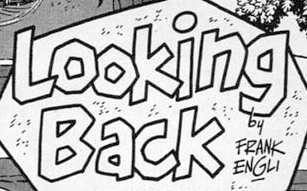Bill Watterson, Charles Schulz, Frank Engli, Alan Foster, and more.
News of new Bill Watterson material prompts Colin McEvoy at Biography to recall what the cartoonist has done between the end of the Calvin and Hobbes comic strip and the impending The Mysteries.
Needless to say, Watterson’s fans are overjoyed about his first major book since Calvin and Hobbes, especially because new material has been so rare for nearly three decades. Here’s what Watterson has been up to since Calvin and Hobbes ended.
McEvoy’s list of Watteson’s prose and cartooning after 1995.

Though it seems he overlooked at least one piece.
Edited to include the other Watterson material mentioned by Mike Rhode in the comments.



Above is the Bill Watterson introduction to the first Cul de Sac collection Cul de Sac This Exit; the drawing Watterrson did for the University Hospitals Cleveland Medical Center; and page one of the conversation Bill had with Richard Thompson about cartooning as published in The Art of Richard Thompson.
In the beginning – early Lucy.
The Lucy described above is the one with whom generations of readers are most familiar – the snark who dispenses psychiatric advice at a nickel a pop, who possesses an unrequited crush on Schroeder, who never lets Charlie Brown kick that blasted football. The girl who was seemingly born fully formed as the fussbudget who slowly transformed into a feminist, to borrow the name of a 2021 exhibition that documented Lucy’s evolution on the funny pages and in the television specials.
This was not the Lucy Van Pelt who debuted in Peanuts on March 3, 1952. Far from it.

An early original Peanuts strip featuring Lucy in a Heritage Auctions offering results in Robert Wilonsky, for Intelligent Collector, to explore The Gentle Beginnings of Lucy Van Pelt.
From letterman to master.
… Meanwhile, Noel Sickles was having success with SCORCHY SMITH, and in 1934, Milton Caniff was asked by the Chicago Tribune Syndicate to launch a new strip called TERRY AND THE PIRATES. It began running Oct 22, 1934. Caniff and Sickles had again formed a studio together In New York, where they helped each other meet deadlines. At first, each artist probably did his own lettering, as was common in the early days of most strips. As Caniff remembered in the interview with Eisner:
It was at that time we decided that between us we’d hire a lettering man. We went back to Engli. Between Sickles and me we were able to afford to have him quit his job and come to work for us.


Todd Klein bio of cartoonist and Milton Caniff letterer Frank Engli.
That other Foster cartoonist.
It’s always a thrill when The Spill hears from a relative of a long-ago New Yorker cartoonist colleague. Last week, I was delighted to hear from Alan Foster’s granddaughter. She kindly offered photos as well as more information about her grandfather.

Michael Maslin with a very brief illustrated profile of cartoonist Alan Foster.
(Not Quite the) 10 Longest Running Comic Strips
Comic strips are an American newspaper tradition. From Dick Tracy to Gasoline Alley, some of these strips ran in syndication for over 100 years.


At CBR Jake Dee compiles a list of the 10 Longest Running Comic Strips.
Except …
Left off the list is Ripley’s Believe It or Not (1918-present) and the Weatherbird (1901-present) which we’ll excuse because they are panels not strips. Also excused is Ginger Meggs (1921-present) as the focus is on U.S. comics.
But Thimble Theatre/Popeye (1919-present) and Fritzi Ritz/Nancy (1922-present) failed to make the list. Even when taking a start date from when they were renamed, both in the 1930s, they beat numbers 7 – 9. Then Apple Mary (1934) was retitled Mary Worth in 1938 and is still running, put it right behind Prince Valaint and around Nancy.
Also left behind are Alley Oop (1932 with a reboot in 1933) and The Phantom (1936), both are still running today. The Phantom’s friend Mandrake the Magician ran from 1934 to 2013. Others that had long lives in newspapers are Bringing Up Father (1913-2000) and Winnie Winkle (1920-1996).
That was with a little research. I’m sure there are more that lasted longer than some of The Ten.

Jake’s a good writer, in surprised he left off so many (much longer-running) comic strips from his list.
Like Dondi…
The Watterson list missed a bunch of stuff besides the Angouleme poster – he did an intro for the first Cul de Sac book, interviewed Richard for a chapter in The Art of Richard Thompson, did a drawing for a hospital’s children’s wing… and that’s just off the top of my head.